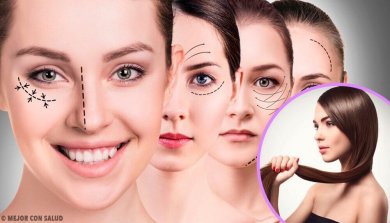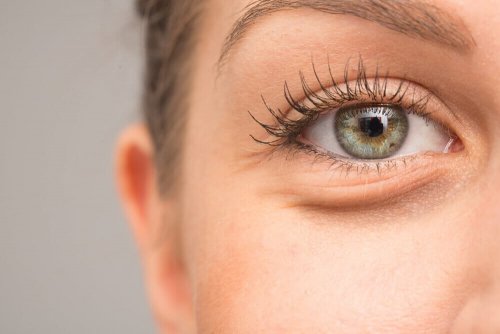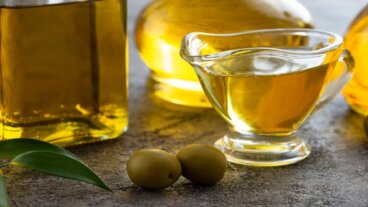7 pflegende Vorteile von Hyaluronsäure


Geschrieben und geprüft von der Ernährungsberaterin Eliana Delgado Villanueva
Hyaluronsäure ist fast überall im Körper vorhanden. Sie ist insbesondere für Haut, Knochen, Gelenke und Bandscheiben sehr wichtig und wird durch Enzyme vom Körper selbst produziert.
Mit zunehmendem Alter geht jedoch der natürliche Anteil von Hyaluronsäure zurück, kann jedoch durch entsprechende Präparate ersetzt werden.
Dieser Mehrfachzucker ist in vielen Schönheitsprodukten zu finden. Erfahre anschließend mehr darüber.
Äußerliche und innere Vorteile von Hyaluronsäure
Wenn du jung aussehen willst, dann ist Hyaluronsäure dein bester Freund. Sie zeichnet sich durch zahlreiche Vorteile aus. Unter anderem sorgt sie für eine klare, elastische und fleckenfreie Haut.
Doch der Mehrfachzucker hat auch andere Vorteile, die wir dir anschließend auflisten:
1. Wirkt gegen Falten

- Dieser Mehrfachzucker versorgt deine Haut mit Feuchtigkeit. In Kombination mit Kollagen strafft die Säure die Haut und hält sie jung.
- Sie formt außerdem eine Schutzbarriere, die deine Haut vor Aggressoren wie Wind und Sonne schützt.
Ab einem Alter von 30 Jahren emfpiehlt es sich, Pflegeprodukte mit Hyaluronsäure zu verwenden.
2. Gegen Akne und Hautflecken
Hyaluronsäure stimuliert die Zellregeneration und reguliert den Feuchtigkeitshaushalt. Sie verhindert auch, dass Talg die Poren verstopft und so Mitesser oder Unreinheiten entstehen.
Außerdem wirkt der Mehrfachzucker gegen Altersflecken. Er verschönt nicht nur deine Haut, sondern ist auch für Augen, Lippen, Zahnfleisch und Haare wichtig.
3. Gesunde Augen

Mit dieser Säure kannst du deine Augen feucht halten und den Transport von Nährstoffen anregen. Außerdem ist es ein perfektes Schmiermittel für den Augapfel.
Dieser Mehrfachzucker ist grundlegend für die Sehkraft und bei Operationen. Ärzte betonen immer wieder, dass die Augen nicht trocken sein sollten.
Zum weiterlesen: 7 Hausmittel für schöne Wimpern
4. Mehr Volumen für die Lippen
Wenn du diesen Feuchtigkeitsspender auf deine Lippen aufträgst hält er sie prall und knackig.
Hyaluronsäure wird von vielen verwendet, um mehr Volumen für die Lippen zu erreichen. Die Wirkung ist nur vorübergehend, doch deutlich sichtbar.
5. Gesundes Zahnfleisch
Hyaluronsäure ist ein wichtiger Bestandteil des Bindegewebes und auch wichtig für das Zahnfleisch. Deshalb wird sie bei verschiedenen Zahnbetterkrankungen verwendet.
Dieses Polysaccharid stärkt die Zähne und hilft bei Zahnfleischentzündungen.
6. Schönes Haar
Auch das Haar profitiert von dieser Säure. Es wird damit stark und glänzt wunderbar. Viele Haarpflegeprodukte enthalten deshalb Hyaluronsäure, insbesondere Mittel für geschädigtes Haar.
Unser Lesetipp: 8 aromatische Öle für besseren Schlaf
7. Knochenschutz und Gelenkschmiere

Gelenkschmiere (Synovia) dient dem Knorpel als Nahrung und ist für gesunde Gelenke unentbehrlich. Sie besteht unter anderem aus Hyaluronsäure. Deshalb wird dieser Mehrfachzucker insbesondere Sportlern empfohlen.
Damit wird die Reibung reduziert, deshalb kannst du dich ohne Schmerzen bewegen und die Verletzungsgefahr mindern.
Mit diesem Polysaccharid als Nahrungsergänzung kannst du bei bestimmten Sportarten das Risiko für Arthritis reduzieren. Auch ältere Menschen können damit ihre Gelenke pflegen.
Wie du siehst hat dieser Mehrfachzucker verschiedenste Vorteile. Auch du kannst dich damit jung halten und pflegen.
Alle zitierten Quellen wurden von unserem Team gründlich geprüft, um deren Qualität, Verlässlichkeit, Aktualität und Gültigkeit zu gewährleisten. Die Bibliographie dieses Artikels wurde als zuverlässig und akademisch oder wissenschaftlich präzise angesehen.
- Boira, C., Essendoubi, M., Meunier, M., Lambert, C., Auriol, D., Manfait, M., Piot, O., Scandolera, A., & Reynaud, R. (2024). Hyaluronic acid: elucidating its penetration into, and effect on hair fibers using confocal Raman spectroscopy and biometric techniques. Journal Of Physical Chemistry & Biophysics. https://www.preprints.org/manuscript/202401.1325/v1
- Bravo, B., Correia, P., Gonçalves Junior, J., Sant’Anna, B., & Kerob, D. (2022). Benefits of topical hyaluronic acid for skin quality and signs of skin aging: From literature review to clinical evidence. Dermatologic therapy, 35(12). https://www.ncbi.nlm.nih.gov/pmc/articles/PMC10078143/
- Bukhari, S., Roswandi, N., Waqas, M., Habib, H., Hussain, F., Khan, S., Sohail, M., Ramli, N., Thu, H., & Hussain, Z. (2018). Hyaluronic acid, a promising skin rejuvenating biomedicine: A review of recent updates and pre-clinical and clinical investigations on cosmetic and nutricosmetic effects. International Journal Of Biological Macromolecules, 120, 1682-1695. https://www.sciencedirect.com/science/article/abs/pii/S014181301833770X
- Dahiya, P., & Kamal, R. (2013). Hyaluronic Acid: a boon in periodontal therapy. North American Journal of Medical Sciences, 5(5), 309–315. https://www.ncbi.nlm.nih.gov/pmc/articles/PMC3690787/
- Desmawati, D., & Sulastri, D. (2019). Phytoestrogens and Their Health Effect. Open access Macedonian journal of medical sciences, 7(3), 495–499. https://www.ncbi.nlm.nih.gov/pmc/articles/PMC6390141/
- Fogagnolo, P., Romano, D., De Ruvo, V., Sabella, P., & Rossetti, L. (2022). Clinical Efficacy of an Eyedrop Containing Hyaluronic Acid and Ginkgo Biloba in the Management of Dry Eye Disease Induced by Cataract Surgery. Journal of ocular pharmacology and therapeutics : the official journal of the Association for Ocular Pharmacology and Therapeutics, 38(4), 305–310. https://pubmed.ncbi.nlm.nih.gov/35442771/
- Frenkel J. (2014). The role of hyaluronan in wound healing. International wound journal, 11(2), 159–163. https://www.ncbi.nlm.nih.gov/pmc/articles/PMC7950635/
- Gupta, R., Lall, R., Srivastava, A., & Sinha, A. (2019). Hyaluronic Acid: Molecular Mechanisms and Therapeutic Trajectory. Frontiers in veterinary science, 6, 192. https://www.ncbi.nlm.nih.gov/pmc/articles/PMC6603175/
- Halachmi, S., Ben Amitai, D., & Lapidoth, M. (2013). Treatment of acne scars with hyaluronic acid: an improved approach. Journal of drugs in dermatology : JDD, 12(7). https://jddonline.com/articles/treatment-of-acne-scars-with-hyaluronic-acid-an-improved-approach-S1545961613P0121X
- Hwang, H., & Lee, C. (2023). Recent progress in hyaluronic-acid-based hydrogels for bone tissue engineering. Gels, 9(7), 588. https://www.ncbi.nlm.nih.gov/pmc/articles/PMC10379028/
- Jensen, G., Attridge, V., Lenninger, M., & Benson, K. (2015). Oral intake of a liquid high-molecular-weight hyaluronan associated with relief of chronic pain and reduced use of pain medication: results of a randomized, placebo-controlled double-blind pilot study. Journal of medicinal food, 18(1), 95–101. https://pubmed.ncbi.nlm.nih.gov/25415767/
- Jung, Y., Hwang, C., Ha, J., Choi, D., Sohn, K., Lee, Y., Seo, Y., Lee, Y., Kim, C., Lee, J., & Im, M. (2017). Hyaluronic Acid Decreases Lipid Synthesis in Sebaceous Glands. The Journal of investigative dermatology, 137(6), 1215–1222. https://pubmed.ncbi.nlm.nih.gov/28163068/
- Litwiniuk, M., Krejner, A., Speyrer, M., Gauto, A., & Grzela, T. (2016). Hyaluronic acid in inflammation and tissue regeneration. Wounds, 28(3), 78-88. https://www.hmpgloballearningnetwork.com/site/wounds/article/hyaluronic-acid-inflammation-and-tissue-regeneration
- Ma, J., Granton, P., Holdsworth, D., & Turley, E. (2013). Oral administration of hyaluronan reduces bone turnover in ovariectomized rats. Journal of Agricultural and Food Chemistry, 61(2), 339–345. https://pubmed.ncbi.nlm.nih.gov/23256527/
- Maulvi, F., Shaikh, A., Lakdawala, D., Desai, A., Pandya, M., Singhania, S., Vaidya, R., Ranch, K., Vyas, B., & Shah, D. (2017). Design and optimization of a novel implantation technology in contact lenses for the treatment of dry eye syndrome: In vitro and in vivo evaluation. Acta biomaterialia, 53, 211–221. https://pubmed.ncbi.nlm.nih.gov/28131945/
- Maulvi, F., Soni, T., & Shah, D. (2015). Extended release of hyaluronic acid from hydrogel contact lenses for dry eye syndrome. Journal of biomaterials science. Polymer edition, 26(15), 1035–1050. https://pubmed.ncbi.nlm.nih.gov/26176811/
- Mehta, V., Kaçani, G., Moaleem, M., Almohammadi, A., Alwafi, M., Mulla, A., Alharbi, S., Aljayyar, A., Qeli, E., Toti, Ç., Meto, A., & Fiorillo, L. (2022). Hyaluronic Acid: A New Approach for the Treatment of Gingival Recession-A Systematic Review. International Journal of Environmental Research and Public Health, 19(21). https://www.ncbi.nlm.nih.gov/pmc/articles/PMC9658310/
- Liu, K. (2020). The hype on hyaluronic acid. Harvard Health Publishing. Consultado el 18 de junio del 2024 https://www.health.harvard.edu/blog/the-hype-on-hyaluronic-acid-2020012318653
- Oe, M., Tashiro, T., Yoshida, H., Nishiyama, H., Masuda, Y., Maruyama, K., Koikeda, T., Maruya, R., & Fukui, N. (2016). Oral hyaluronan relieves knee pain: a review. Nutrition journal, 15, 11. https://www.ncbi.nlm.nih.gov/pmc/articles/PMC4729158/
- Palmieri, B., Merighi, A., Corbascio, D., Rottigni, V., Fistetto, G., & Esposito, A. (2013). Fixed combination of hyaluronic acid and chondroitin-sulphate oral formulation in a randomized double blind, placebo controlled study for the treatment of symptoms in patients with non-erosive gastroesophageal reflux. European review for medical and pharmacological sciences, 17(24), 3272–3278. https://pubmed.ncbi.nlm.nih.gov/24379055/
- Pereira, T., Jüni, P., Saadat, P., Xing, D., Yao, L., Bobos, P., Agarwal, A., Hincapié, C., & da Costa, B. (2022). Viscosupplementation for knee osteoarthritis: systematic review and meta-analysis. BMJ (Clinical research ed.), 378, e069722. https://pubmed.ncbi.nlm.nih.gov/36333100/
- Pinto, J., López, A., Blázquez, F., Urbano, R., & González, M. (2017). Efficacy and Safety of 0.2% Hyaluronic Acid in the Management of Dry Eye Disease. Eye & contact lens, 43(1), 57–63. https://pubmed.ncbi.nlm.nih.gov/26783978/
- Savarino, V., Pace, F., Scarpignato, C., Esoxx Study Group, Astegiano, M., Calabrese, C., … & Segato, S. (2017). Randomised clinical trial: mucosal protection combined with acid suppression in the treatment of non‐erosive reflux disease–efficacy of Esoxx, a hyaluronic acid–chondroitin sulphate based bioadhesive formulation. Alimentary pharmacology & therapeutics, 45(5), 631-642. https://www.ncbi.nlm.nih.gov/pmc/articles/PMC5347926/
- Sundaram, H., Mackiewicz, N., Burton, E., Peno-Mazzarino, L., Lati, E., & Meunier, S. (2016). Pilot Comparative Study of the Topical Action of a Novel, Crosslinked Resilient Hyaluronic Acid on Skin Hydration and Barrier Function in a Dynamic, Three-Dimensional Human Explant Model. Journal of drugs in dermatology: JDD, 15(4), 434–441. https://pubmed.ncbi.nlm.nih.gov/27050698/
- Yang, Y., Lee, W., Kim, Y., & Hong, Y. (2021). A Meta-Analysis of the Efficacy of Hyaluronic Acid Eye Drops for the Treatment of Dry Eye Syndrome. International Journal of Environmental Research and Public Health, 18(5), 2383. https://www.ncbi.nlm.nih.gov/pmc/articles/PMC7967738/
Dieser Text dient nur zu Informationszwecken und ersetzt nicht die Beratung durch einen Fachmann. Bei Zweifeln konsultieren Sie Ihren Spezialisten.








